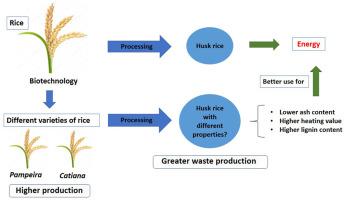Biomass & Bioenergy ( IF 6 ) Pub Date : 2020-10-09 , DOI: 10.1016/j.biombioe.2020.105816 Carlos Guilherme Lopes Grotto , Carla Jovania Gomes Colares , Daniel Rodrigues Lima , Douglas Henrique Pereira , Ailton Teixeira do Vale

|
This work aimed to characterize and evaluate the energy potential of the residual biomass of genetically improved rice varieties (Pampeira rice and Catiana rice) introduced in the Brazilian market in 2016 and an indefinite variety of rice to establish a comparison. The two varieties of rice species enabled an increase in producers' profits of up to 57% and therefore with high production of residues and without problems of supply. The thermogravimetric analysis (TGA), middle and near infrared spectroscopy were used to characterize the biomass. The TGA curves evidenced the degradation of lignocellulosic matter as hemicellulose and cellulose (120 °C and 350 °C) and lignin (350 °C and 600 °C). The middle and near infrared spectroscopy identified the main characteristic bands of the rice husks: O−H, Si−OH, −CH2, −CH3, C=O and C−O. The elementary analysis showed that the percentage of carbon 40.68% and 42.29% and the total lignin 33.21% and 31.55% for Catiana and Pampeira rice husk, respectively, have a good potential for generating useful energy. The higher heating values (HHV) 4409.50 kcal kg−1 and 4488.00 kcal kg−1 for Catiana and Pampeira risk husk evaluate and proven the energetic potential of these materials. On the other hand, the ash content determined is lower, which facilitates its application in the combustion process. The theoretical results showed that the lignin presents greater enthalpy of combustion, when compared with hemicellulose and cellulose, confirming the results of the experiments found in the work.
中文翻译:

巴西两种经过基因改良的稻壳的生物质的能量潜力:一项理论实验研究
这项工作旨在表征和评估转基因水稻品种(Pampeira水稻和Catiana)剩余生物质的能量潜力大米)于2016年在巴西市场上推出,并且可以使用不确定种类的大米进行比较。这两种水稻品种使生产者的利润增加了57%,因此残留物的产量高,而且没有供应问题。使用热重分析(TGA),中红外光谱和近红外光谱来表征生物质。TGA曲线证明木质纤维素物质降解为半纤维素和纤维素(120°C和350°C)和木质素(350°C和600°C)。中红外光谱和近红外光谱确定了稻壳的主要特征谱带:OH,Si-OH,-CH 2,-CH 3,C = O和CO。元素分析表明,卡蒂亚纳和潘佩拉稻壳的碳含量分别为40.68%和42.29%,总木质素为33.21%和31.55%,具有产生有用能量的良好潜力。较高的热值(HHV)4409.50千卡千克-1和4488.00千卡千克-1为Catiana和Pampeira风险外壳评估并证明了这些材料的潜力。另一方面,确定的灰分含量较低,这有利于其在燃烧过程中的应用。理论结果表明,与半纤维素和纤维素相比,木质素具有更高的燃烧焓,从而证实了在工作中发现的实验结果。



























 京公网安备 11010802027423号
京公网安备 11010802027423号